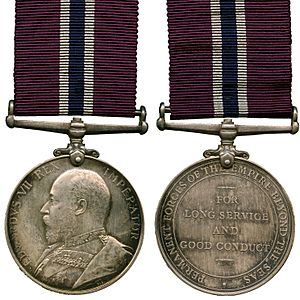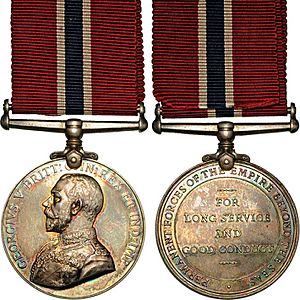Permanent Forces of the Empire Beyond the Seas Medal facts for kids
Quick facts for kids Permanent Forces of the Empire Beyond the Seas Medal |
|
|---|---|

King Edward VII version
|
|
| Country | |
| Type | Military long service medal |
| Eligibility | Permanent Force Other Ranks of the Dominions and Colonies |
| Awarded for | 18 years service and good conduct |
| Status | Discontinued in 1930 |
| Statistics | |
| Established | 1910 |
| Order of Wear | |
| Next (higher) | |
| Equivalent | |
| Next (lower) | |
The Permanent Forces of the Empire Beyond the Seas Medal was a special award given to soldiers. It was for those who served for a long time and showed good behavior. This medal was created for soldiers in the permanent forces of the British Empire's Dominions and Colonies. These were countries like Canada, Australia, and South Africa that were part of the British Empire.
This medal was also known as the Permanent Overseas Forces Long Service and Good Conduct Medal. It was started in 1910 by King Edward VII. Its main purpose was to replace many different local medals. Before 1910, each territory had its own version of the Army Long Service and Good Conduct Medal. This new medal made things simpler.
In 1930, this medal was replaced by a new one. It was called the Medal for Long Service and Good Conduct (Military). This new medal also had different versions for various territories.
Contents
Why This Medal Was Created
Before 1910, many parts of the British Empire had their own medals. These were given to soldiers for long service and good conduct. The United Kingdom had its own Army Long Service and Good Conduct Medal since 1830.
Over time, other territories like Canada and Australia started giving similar medals. These medals looked a lot like the British one. But they had the name of their own territory on them. For example, there were medals for the Cape of Good Hope and Natal.
When Edward VII became King in 1901, new versions of these medals were made. They showed his picture. For Australia, which had become a single country in 1901, five different medals were replaced. They were all changed to one medal for the "Commonwealth of Australia."
To make things even simpler, King Edward VII created the Permanent Forces of the Empire Beyond the Seas Medal in 1910. This medal replaced all those different territorial medals. It became a single award for soldiers across the Empire.
Who Could Get the Medal?
This medal was for soldiers who served in the permanent forces. These were the regular armies of the Dominions and Colonies. To get the medal, a soldier had to serve for eighteen years. They also had to show excellent behavior during their service.
The medal was specifically for forces "beyond the seas." This means it was not for soldiers serving in the United Kingdom itself. They continued to receive the Army Long Service and Good Conduct Medal.
At first, only army members could get this medal. But from 1920, it was also given to members of the Air Forces. This happened as new air forces were created in the Empire, like the South African Air Force.
The medal was made in London by the Royal Mint. But the local governments in each territory decided who would receive it.
What the Medal Looks Like
The medal is a round silver disk. It has a special design on both sides.
Front Side (Obverse)
The first version of the medal showed King Edward VII. He is wearing a Field Marshal's uniform and facing left. Around the edge, it says "EDWARDVS VII REX IMPERATOR." This means "Edward VII King Emperor."
After King George V became King in 1911, a second version was made. This one shows King George V in his Field Marshal uniform, also facing left. Around the edge, it says "GEORGIVS V BRITT: OMN: REX ET IND: IMP:". This means "George V, King of all the Britains and Emperor of India."
Back Side (Reverse)
The back of the medal has a smooth surface. Around the edge, it says "PERMANENT FORCES OF THE EMPIRE BEYOND THE SEAS." In the middle, it says "FOR LONG SERVICE AND GOOD CONDUCT" in four lines.
Ribbon
The medal hangs from a colorful ribbon. The ribbon has bands of crimson (dark red), white, and dark blue.
Who Received This Medal?
Many soldiers received this medal. For example, in Canada, 839 medals were given to members of the Canadian Army. One medal was also given to a member of the Royal Canadian Air Force.
When the Medal Ended
The Permanent Forces of the Empire Beyond the Seas Medal stopped being awarded in 1930. King George V created a new medal to replace it. This new medal was called the Medal for Long Service and Good Conduct (Military). It was for all regular and permanent military forces of the British Empire.
The new medal had special bars attached to it. These bars showed which territory the soldier was from. For example, the South African version had words in two languages on the back.
Images for kids


